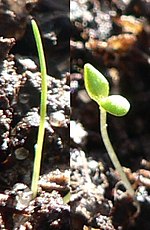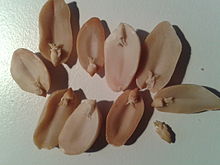ബീജപത്രങ്ങൾ
ഒരു ബീജപത്രമെന്നാൽ A cotyledon (/kɒtɪˈliːdən//kɒtɪˈliːdən/; "seed leaf" from Latin cotyledon,[1] from Greek: κοτυληδών kotylēdōn, gen.: κοτυληδόνος kotylēdonos, from κοτύλη kotýlē "cup, bowl") ഒരു സസ്യത്തിന്റെ വിത്തിലുള്ള ഭ്രൂണത്തിന്റെ നിർണ്ണായകമായ ഭാഗമാണ്. ഇംഗ്ലിഷ് ഓക്സ്ഫഡ് നിഘണ്ടു അനുസരിച്ച് "ഉയർന്ന സസ്യങ്ങളിലെ (ഫാനെറോഗാമസ്) ഭ്രൂണത്തിന്റെ പ്രാഥമിക ഇലകൾ ആണ്."[2] മുളയ്ക്കുന്നസമയത്ത് ബീജപത്രങ്ങൾ ഭ്രൂണത്തിന്റെ ആദ്യ ഇലകൾ ആയി മാറുന്നു. ബീജപത്രങ്ങളുടെ എണ്ണമനുസരിച്ച് സസ്യശാസ്ത്രജ്ഞർ സപുഷ്പികളായ സസ്യങ്ങളെ തരംതിരിച്ചിരിക്കുന്നു. ഒരു ബീജപത്രം മാത്രമുള്ള സസ്യങ്ങളെ ഏകബീജപത്രസസ്യങ്ങൾ എന്നും രണ്ടു ബീജപത്രങ്ങളുള്ള സസ്യങ്ങളെ ദ്വിബീജപത്രസസ്യങ്ങളെന്നും തരംതിരിച്ചിട്ടുണ്ട്.




